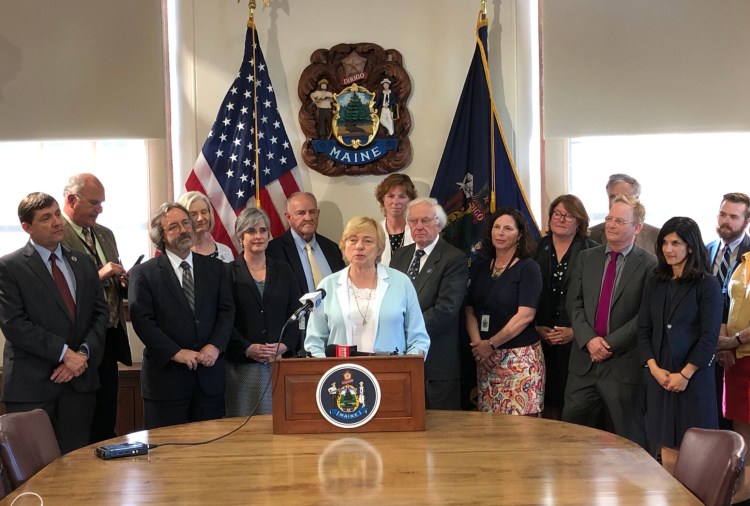AUGUSTA — Gov. Janet Mills signed a two-year, nearly $8 billion budget Monday that she said includes “meaningful and important steps to invest in Maine’s future.”
Flanked by legislative leaders and lawmakers from both parties, Mills praised the bipartisan cooperation involved in crafting a budget that increases funding for education and social services without raising taxes. The two-year budget also provides additional revenue sharing to municipalities, seeks to move the state toward a new $40,000 minimum teacher salary and hires dozens more child protection workers.
“I’m so proud of all of the work that lawmakers on both sides of the aisle have put into this, and I’m proud of the bipartisan agreement that was reached,” Mills said moments before signing the first budget of her administration. “Like all compromises, nobody got everything they wanted. But this budget takes some meaningful and important steps to invest in Maine’s future.”
The $7.98 billion budget includes:
•$125 million for voter-approved Medicaid expansion.
•An additional $111 million for K-12 education and $17 million more for public colleges and universities.
•$75 million more in “revenue sharing” to help reduce pressure on local property taxes.
•An increase in the Homestead Exemption for homeowners from $20,000 to $25,000.
The House and Senate approved the budget late Friday on bipartisan votes after members of the Legislature’s Appropriations and Financial Affairs Committee spent months fine-tuning the spending plan based on Mills’ initial proposal. And Mills signed the budget into law with two weeks to spare after Democratic and Republican lawmakers avoided the partisan battles that led to a brief government shutdown two years ago.
During that stalemate, tempers flared at the State House as former Gov. Paul LePage worked with his allies in the House Republican caucus to force additional concessions on tax issues. Budget negotiations have been much more congenial this year thanks to a change in tenor at the State House.
“I believe through this process we have returned an air of civility and bipartisan agreement to state government that may have been lacking in the recent past,” Mills said. “This is the type of government that Maine people deserve.”
The budget proposal that Mills unveiled in February – roughly one month after she became Maine’s first female governor – served as a starting point for legislative budget negotiators. The proposal contained much of Mills’ high-profile campaign promises, such as fully funding Medicaid expansion and investing additional money in K-12 education without raising taxes.
But Republican lawmakers called Mills’ budget “unsustainable” because it proposed spending nearly all of the anticipated tax revenue without taking into account a possible economic downturn. They also bristled at the roughly $8 billion cost, which represented an 11 percent increase over the previous two-year budget.
In the end, the final budget deal came in just shy of $8 billion, as Republicans had insisted. Lawmakers also made some substantial changes to Mills’ original proposal. But they went along with Mills’ subsequent proposal to add nearly $20 million to the state’s rainy day fund following more positive revenue forecasts.
The work of the Appropriations and Financial Affairs Committee is not over, however, as legislative leaders aim to wrap up the 2019 regular session by Wednesday.
The committee must still recommend how large a bond package to send to state voters to fund highway and transportation infrastructure projects, research and development, energy efficiency and land conservation. The Mills administration has proposed a $239 million bond package.
The committee also will have to decide which of the hundreds of bills lingering on the so-called Special Appropriations Table should receive money this year. All but a select few of those bills, which have all received approval by both the House and Senate, will likely “die on the table” for lack of funding.
Send questions/comments to the editors.



